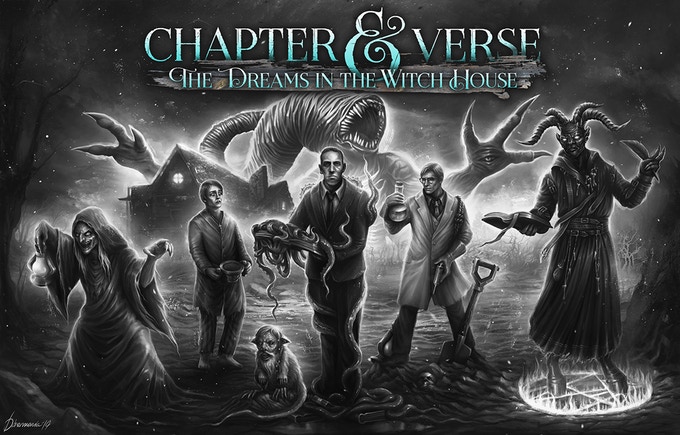Inspired by the awesome-looking figures being produced by Workhouse Games, I decided to revisit one of my favorite Lovecraft tales, Dreams in the Witch House. I honestly cannot recall when I last read it, but it has some great characters that the Kickstarter is bringing to life.
I decided to approach this in a couple of ways. I would listen to the Dark Adventures Radio Theatre audio drama version from our friends at the H.P. Lovecraft Historical Society, and read the story. I thought about also watching the Masters of Horror version of it, but I recall not being wowed by that, so I’ll forego that.
The story starts off introducing Walter Gilman. He’s student at Miskatonic, a gifted mathematician and folklore dabbler who is troubled by a brain fever and the dreams it causes. Or did the dreams cause the fever? Like Lovecraft, Mr. Gilman does not strive to maintain his health. There are frequent mentions of the need to visit a specialist, but Gilman never quite makes time for that appointment.
The dreams bring about some weird, trippy visions which are called indescribable but are nonetheless described. They are subtle and suggestive, and sometimes Lovecraft’s prose gets in the way. However, it’s rewarding to carefully sift through the vast gulf of adjectives to see what’s hinted at.
The witch in the witch house is Keziah Mason, described as a mundane old woman who suddenly and inexplicably becomes a mathematical genius. This is shocking and the intolerant people of Arkham turn against her, suspecting some pact with dark powers. In their defense, if I were to suddenly demonstrate mathematical genius, most people who know me would (perhaps rightly so) suspect the same thing.
Keziah is delightfully menacing. However, the real treat is Brown Jenkin, her awful human-faced rat familiar with human hands for paws. Keziah and Brown Jenkin are some of the evilest characters in Lovecraft’s works, right up there with Wilbur Whately.
The story itself concerns the seduction of Gilman, initially through his exploration of esoteric mathematics and its potential for opening paths through space and time. In this he is drawn along by Mason visiting times and places, encountering strange beings along the way. (I was delighted by the appearance of the Elder Things, something I had either missed entirely or forgotten from my earlier readings.) This less malignant journey evolves into darker business later in the tale.
I found the second half of the story more enjoyable than first. The dreams themselves were a bit of a slog for me. The cleaner, more realized scenes later on were more enjoyable. As a character, Gilman was heroic in his efforts, if not in his results. All in all, it was a very enjoyable read.
Listening to the HPLHS Dark Adventure Radio Theater (DART) audio dramatization around the same time I was reading the story allowed for some fun comparing and contrasting between the two depictions. The audio drama adds life to many of the characters mentioned in the story. All of this helps to enhance the enjoyment. The narrative element which the audio drama necessitates adds to the experience. This is well done with this particular addition to the DART series. Just enough was added to the story to enhance things. I would have liked to have heard a few more things from the final portion of the story related to the fate of the Witch House itself, but more attention was paid to the characters. This is a quibbling thing. All in all, the production was rich and added to the experience.
In summation, Dreams in the Witch House is a fine story. I encourage you all to crack open your copy of the story and give it an another read. The minis from the Workhouse Games Kickstarter help to visualize the characters brilliantly. Finally, the HPLHS DART audio drama rounds out the experience by giving voice to the characters you meet along the way. Pleasant dreams!

